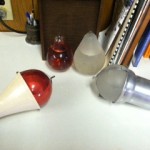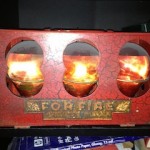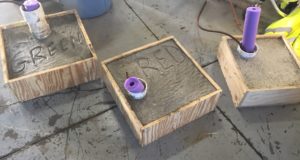Below is an article from Victoria Williams of the Gloucester County Times on the old school glass bulb fire grenades. All credit to Victoria for the history lesson write-up. Just another great piece of fire service history to keep us tied to our roots and encourage further training as things change…Enjoy the read.
“LIKE” FIRST DUE TACKLE ON FACEBOOK
Extinguishing fires before they spread has always been a problem. Glass fire grenades were used widely for over 40 years. Glass fire grenade was manufactured between 1870 and 1910. The grenade resembled a ball-shaped light bulb but was larger. It was also produced in a tear-shape and a rolling pin shape.
Victorian homes and public buildings were furnished with glass fire grenades. They were hung on a wall bracket and were filled with carbon tetrachloride. The glass was thin enough to shatter easily when thrown into the flames. The glass grenade was made to be easily broken and destroyed as it served its purpose of extinguishing a fire. The fire grenades were sealed with cork and a cement to keep the contents from evaporating.
Early glass fire grenades were full of a salt water solution with added bicarbonate of soda or muriate of ammonia. Due to the use of salt water as an ingredient the fire grenade was advertised as non-freezing. Carbon tetrachloride, a dangerous chemical, was used as the fire deterrent in many glass fire grenades. At that time the dangers of its use to the body were unknown. It can cause damage to the lungs, liver, kidneys and the brain. The carbon tetrachloride is easily absorbed into the body through the skin and lungs. People of the late 1800s were not aware of this.
Carbon tetrachloride was used in making refrigeration fluid and as a cleaning fluid by dry cleaners during the last century. It is now banned and is considered a hazardous material. However the fire grenade worked by robbing the fire of oxygen through a chemical reaction.
The glass fire grenade was designed to be used like a military grenade — thrown at the fire to put it out. So the grenade usually had a long neck in order to grasp it. It had a decorative round body, looked like a bottle, and was made in a variety of colors — cobalt blue, olive yellow, green and clear.
The tear-drop shaped glass grenades were made to be placed in a wire rack on the wall in a strategic place. The pointed end was placed in the hole of the rack.
Fire grenades ranged anywhere from 5 7/8 inches to 8 1/4 inches high. A tubular style fire grenade resembling a large chemistry tube or rolling pin was also produced. This variety was also made in various colors, was decorative, and was about 17 3/4 inches high. The tube or rolling pin variety was mounted on the wall in a cast iron mount. Some grenades were made in the shape of a glass chimney with the bottom closed. This type could easily be set in a rack. It was commonly filled with a brine solution and mounted in railcars.
Some of the companies that produced glass fire grenades were the Harden Hand grenade, W.D. Allen Manufacturing Company, Fire Extinguisher M.F.G. Company, Acme Fire Extinguisher, Comet, Hayward, Babcock, Harkness and Little Giant. Many of the glass grenades were embossed with the manufacturer’s name. Many people today do not know that these beautiful and very decorative glass bottles are really fire extinguishers. However, isn’t it ironic that glass fire grenades considered to be so practical for fire safety over a hundred years ago are now found to be toxic and dangerous to humans today if still filled with carbon tetrachloride? See The Original Article Here
“Like” Ryno Concealment on Facebook
Pass it on!
 First Due Tackle Pass It On – Firefighter, Rescue & Extrication Training
First Due Tackle Pass It On – Firefighter, Rescue & Extrication Training







